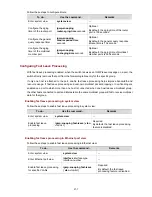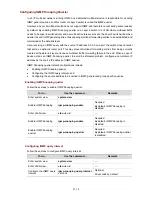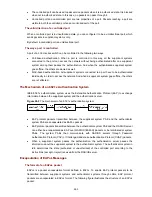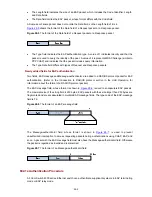
27-19
Device
Device description
Networking description
Host A
User 1
Host A is connected to Ethernet 1/0/1 on Switch B.
Host B
User 2
Host B is connected to Ethernet 1/0/2 on Switch B.
In this configuration example, you need to configure the ports that connect Switch A and Switch B to
each other as hybrid ports. The following text describes the configuration details. You can also configure
these ports as trunk ports. The configuration procedure is omitted here. For details, see
Configuring
Multicast VLAN
.
Configure a multicast VLAN, so that users in VLAN 2 and VLAN 3 can receive multicast streams
through the multicast VLAN.
Network diagram
Figure 27-4
Network diagram for multicast VLAN configuration
WorkStation
SwitchA
SwitchB
Vlan-int20
168.10.1.1
Eth1/0/1
Eth1/0/10
Vla
n2
Vlan
3
Eth1/0/10
Vlan10
Eth
1/0
/1
Eth
1/0/2
HostA
HostB
Vlan-int10
168.10.2.1
Configuration procedure
The following configuration is based on the prerequisite that the devices are properly connected and all
the required IP addresses are already configured.
1) Configure Switch A:
# Set the interface IP address of VLAN 20 to 168.10.1.1 and enable PIM DM on the VLAN interface.
<SwitchA> system-view
[SwitchA] multicast routing-enable
[SwitchA] vlan 20
[SwitchA–vlan20]port Ethernet 1/0/1
[SwitchA-vlan20] quit
[SwitchA] interface Vlan-interface 20
[SwitchA-Vlan-interface20] ip address 168.10.1.1 255.255.255.0
[SwitchA-Vlan-interface20] pim dm
[SwitchA-Vlan-interface20] quit
# Configure VLAN 10.
[SwitchA] vlan 10
[SwitchA-vlan10] quit
# Define Ethernet 1/0/10 as a hybrid port, add the port to VLAN 10, and configure the port to forward
tagged packets for VLAN 10.
[SwitchA] interface Ethernet 1/0/10
[SwitchA-Ethernet1/0/10] port link-type hybrid















































